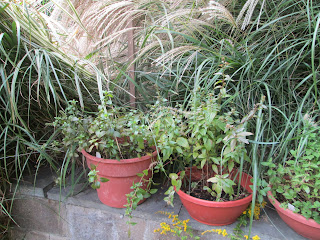 |
| The Herb Society (UK) A Multitude of Mints by Guy Cooper & Gordon Taylor |
 |
| The Best Way to Curtail the Spread of Mint! |
Mints have these basics in common:
1. Mints have square stems.
2. They have opposite single leaves.
3. White to purple flowers formed in clusters
4. Mints spread quickly underground.
5. Mints are very invasive in any garden unless controlled.
6. All are perennial.
Mints are very easy to grow. They do not like compacted and heavy soils. The ideal planting area is a warm, sheltered south-facing one with partial shade, as the essential oil seems to evaporate if mints are planted in full sun. Propagation is best and easily done by root division in spring or autumn. Personally I think it could be done in winter if you have a mild one. Beds should be renewed every two or three years which will improve the quality and growth habit. A separate pot of mint will grow on an east facing windowsill very easily. The soil should be kept moist but not waterlogged! It is easy for a plant to die because of too much water which is unnecessary. The book mentioned that mints can get rust and have problems with red spider mites. Here in southwestern Pennsylvania my main problem for mint is the four lined plant bug who love all square stem plants, including mint! Here is a post I did for Herb Companion (now Mother Earth Living) called Herbal Pests: The Four-Lined Plant Bug. In that post you will see a photo of the damage it does to peppermint! The good news is there is only one generation a season. Some years they do a lot of damage and others not so much.
 |
| This is Damage on Oregano, but Mint Gets This Same Damage |
 |
| Here are the Four-Lined Plant Bugs That Damaged Square Stems Herbs, such as Mint! |
It should be harvested in bud and not in full flower. Harvest in the late morning or late afternoon. If mint is wet when harvested, it will turn black and not dry well. Good air circulation give mint good color when drying. The easiest way of preservation is drying on a line or between paper towels or freezing in ice cube trays or in plastic bags or containers.
One of the earliest mentions of mint is in the New Testament of the Bible in Luke 11:42 which talks of tithes of mint, anise and cumin which the Pharisees were commanded to pay. Greek mythology also talks of mint including how the genus got its name Mentha. The two forms of mint in ancient times were wild water mint and pennyroyal which was also known as flea mint.
Mint was used in ancient times as a strewing herb to drive away mice and insects. It was also used in bathing, cosmetics and medicines. Mints are found on all medieval plant lists. Culpeper lists almost forty diseases for which mint is 'singularly good.'
A healthy mint leaf fresh or dried can be used interchangeably without affecting the taste of the dish. You only have to use a quarter dried to fresh in any recipe. I really don't use mint too much because of my GERD or reflux disease. It gives me a major bout of coughing. So I stay away. And mint and chocolate which is a favorite of many people around the world is really a no no for me. I do use some spearmint, pineapple or orange mint in my tea blends and they don't seem to affect me as much as peppermint does.
I would like to try some of the recipes in this booklet such as:
Mint Jelly
Mint and Parsley Salad
Moroccan Mint Tea
Mint has been used for centuries as an antiseptic, appetizer and digestive. In 1981 Egypt was the largest producer of spearmint. Now it is the United States, India and China that are all major producers. Because it has been so mild here, I will be harvesting a bit more mint to dry in the coming days. Hope you are enjoying these booklet reviews. I'll talk about the final one about rosemary in Friday's post. It was a mild beautiful day. Halloween will be a bit soggy here. Happy Halloween everyone!
 |
| Happy Halloween from Our House to Yours! |
2 comments:
eww...we get that 4 lined bug down south too...it doesn't seem like I see it every year tho...I had noticed it in my rosemary one year really bad. I can't wait to see what new recipes you come up with on the jellies. Haven't had time yet to try your sage recipe...but really excited about it! Thanks for all your tips!!! xo
The stink bug has taken my life over even over the four-lined plant bug, Pammy! Got to remind me about the jelly recipe. xo
Post a Comment